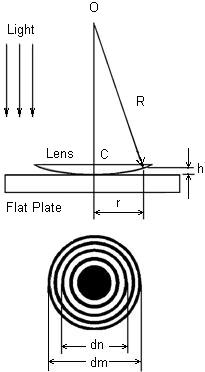
Schematic of a lens and a flat plate used to form Newton’s rings
Note: VGA monitor not included
Features
Microscopic CMOS color camera with displacement cursor
Newton's ring pattern displayed on VGA color monitor
Direct measurement using keypad controlled cursor on LCD color monitor
Camera and Sodium lamp available for other applications
Introduction
The LEOK-31 Newton's Ring Experiment Apparatus - Enhanced Model is an advanced version of the classic Newton's Rings experiment. It leverages modern technology to provide a more precise and efficient way to observe and measure the Newton's Ring interference pattern. This model incorporates an area VGA output color camera with a microscopic lens to capture the interference pattern, and the acquired pattern is displayed on a LCD monitor. This enhanced setup allows for accurate fringe measurements with keypad-controlled cursors, improving the overall learning experience.
Key Features:
High-Resolution Camera Integration: The area VGA output color camera with a microscopic lens captures the Newton's Ring interference pattern in high resolution, providing clear, detailed images for analysis.
LCD Monitor for Real-Time Observation: The interference pattern is displayed in real-time on an LCD monitor, allowing students to closely observe the phenomenon and make immediate measurements.
Precision Measurement Tools: The system includes keypad-controlled cursors on the LCD monitor, enabling students to directly measure the separation between interference fringes and calculate the radius of curvature of the spherical surface with greater accuracy.
Monochromatic Light Source: The setup uses a monochromatic light source to illuminate the spherical and flat surfaces, ensuring clear and distinct interference rings.
The instruction manual contains comprehensive materials including experimental configurations, principles and step-by-step instructions. Please click to view some sample pages of the instruction manual.
Specifications
| Item | Specifications |
| Light Source | low pressure sodium lamp, 20 W |
| Newton's Ring Device | radius of curvature: ~868.5 mm; diameter: 32 mm; transmissive |
| Electronic Scale | resolution: 0.01 mm; viewing field: ~ 10 mm |
CMOS Color Camera | sensor size: 1/4" |
| resolution: 1280 × 1024 | |
| pixel size: 2.8 μm x 2.8 μm | |
| bit: 8 | |
| output format: VGA | |
| frame rate: 15 Hz | |
| optical mount: C/CS | |
| function setting: via keypad and menu | |
| menu functions: brightness, contrast, saturation, sharpness, tone, cursor, length | |
| Camera Lens | focal length: 25 mm |
Part List
| Description | Qty |
| Sodium lamp with housing and power supply | 1 set |
| CMOS color camera with AC adapter | 1 set |
| Camera lens with extension ring | 1 |
| Newton's ring assembly | 1 |
| Beam splitter with mount and post | 1 set |
| Camera stand with focusing knob | 1 set |
| Keypad | 1 |
| VGA flat panel monitor (optional) | 1 |

Schematic of a lens and a flat plate used to form Newton’s rings